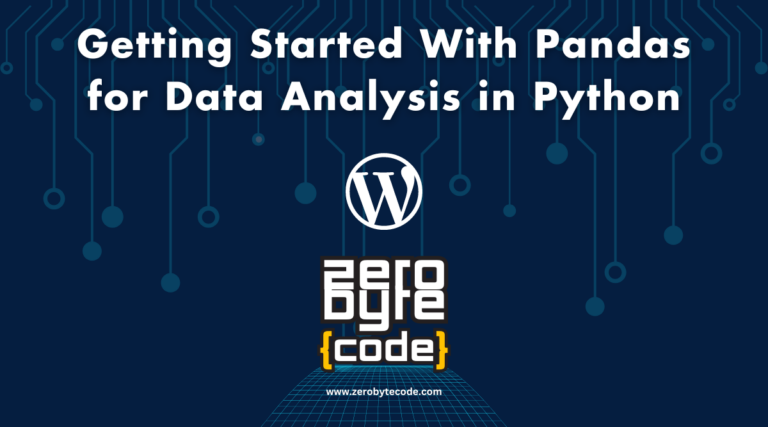Data Representation in Python: A Comprehensive Guide
Data representation in Python serves as a foundational element for effective programming, impacting how data is stored, accessed, and manipulated within various applications.
This extensive guide will explore the breadth of built-in data types, ranging from simple numeric types to complex structures like dictionaries and sets, while also addressing advanced frameworks such as Pandas DataFrames and NumPy arrays.
Principal Conclusions
Hide- Data representation in Python is crucial for optimizing algorithms, enhancing performance, and ensuring maintainable software development.
- Python provides various built-in data types, including numeric types, strings, lists, tuples, dictionaries, and sets for effective data manipulation.
- Mastering Python's numeric types, such as integers and floats, is essential for efficient numerical analysis and complex calculations.
- Pandas DataFrames and Series enable efficient handling of structured data, supporting operations like filtering, grouping, and aggregation.
- Understanding data representation principles prevents performance bottlenecks and promotes innovative coding solutions in Python.
Understanding these concepts not only enhances code readability but also optimizes performance. As we navigate through these essential topics, one might wonder how mastering these techniques can transform your approach to data-centric challenges.
Understanding Data Representation
Data representation serves as a fundamental building block in programming, influencing how information is stored, processed, and manipulated.
The choice of data types and structures directly impacts performance, memory utilization, and overall code efficiency.
Understanding these aspects is essential for optimizing algorithms and ensuring robust software development.
The Importance of Data Representation in Programming
Data representation in programming, particularly in Python, serves as the foundation for data manipulation and analysis.
Understanding its principles is essential, as improper data representation can lead to significant inefficiencies and errors in code execution.
This discussion will explore the definition of data representation and the potential repercussions of inadequate practices in Python.
What Is Data Representation and Why Is It Crucial in Python?
In the domain of programming, effective data representation is fundamental, as it determines how information is organized, stored, and manipulated within the Python environment.
Proper data representation facilitates efficient computation, enhances code readability, and supports advanced data structures.
Consequences of Poor Data Representation in Python
Ineffective data representation can lead to significant performance bottlenecks, increased complexity, and challenges in maintaining code integrity within Python applications.
Poorly structured data types can hinder algorithm efficiency, resulting in slower execution times.
Additionally, inadequate representation may complicate debugging and hinder scalability, ultimately stifling innovation.
Prioritizing ideal data representation is essential for creating robust, maintainable, and high-performance Python applications.
Data Types in Python
Python offers a robust set of built-in data types that serve as the foundational elements for data manipulation and representation.
This section will explore key data types, including integers, floats, complex numbers, and strings, highlighting their characteristics and usage.
Understanding these data types is essential for effective programming and data handling in Python.
Introduction to Built-in Data Types in Python
Python provides a range of built-in data types that facilitate various forms of data representation and manipulation.
Key categories include numeric types, Boolean values, and sequence types, which form the foundation for more complex structures.
Additionally, mapping and set data types offer unique capabilities for organizing and managing collections of data efficiently.
Overview of Numeric, Boolean, and Sequence Data Types
Three fundamental data types in Python—numeric, boolean, and sequence—serve as the building blocks for data manipulation and representation within the language.
Numeric types facilitate mathematical operations, booleans enable logical decision-making, and sequences (such as lists and tuples) provide ordered collections of data.
- How to Scrape Websites Using Python With Cloudscraper
- How to Create an API From Scratch Using Python and Flask
- Python Web Scraping Using Selenium Tutorial
- How to Use asyncio to Scrape Websites with Python
- How to Set Up a Proxy for Web Scraping in Python
- Web Scraping With Python: A Complete Step-By-Step Guide + Code
Understanding these types is essential for leveraging Python’s capabilities in innovative data-driven applications and efficient algorithm design.
Explanation of Mapping and Set Data Types
Mapping and set data types in Python offer powerful mechanisms for organizing and managing collections of data, each serving distinct purposes in data representation and manipulation.
Mappings, exemplified by dictionaries, facilitate key-value pair associations, enhancing data retrieval efficiency.
Sets, on the other hand, provide a unique collection of unordered elements, enabling rapid membership testing and mathematical operations, thereby fostering innovative data handling techniques.
Working with Integers, Floats, and Complex Numbers
In Python, integers, floats, and complex numbers serve as fundamental data types for representing numerical values.
Understanding basic operations applicable to these types is essential for effective programming, as it enables the execution of arithmetic and logical computations.
Additionally, leveraging advanced mathematical functions enhances the capabilities of numerical analysis and manipulation within the Python environment.
Basic Operations on Numeric Data Types
Basic operations on numeric data types in Python encompass a range of functionalities, including arithmetic, comparison, and type conversion, which are essential for effective data manipulation and analysis.
These operations empower developers to:
- Streamline data processing.
- Enhance computational efficiency.
- Facilitate dynamic data analysis.
- Innovate solutions across various domains.
Mastering these fundamentals is key to utilizing Python’s full potential in numerical applications.
Using Advanced Mathematical Functions in Python
Advanced mathematical functions in Python provide robust tools for performing complex calculations with integers, floats, and complex numbers, thereby enhancing the precision and efficiency of numerical analysis.
Libraries such as NumPy and SciPy offer a suite of functions for linear algebra, statistical analysis, and calculus, enabling seamless integration of advanced mathematical techniques into data-driven applications and fostering innovation in computational problem-solving.
Understanding Strings in Python
Strings are a fundamental data type in Python, representing sequences of characters that can be manipulated through various techniques.
This discussion will cover the processes of creating, indexing, and slicing strings, along with exploring the wide array of string methods and formatting options available in Python.
Understanding these functionalities is essential for effective data manipulation and representation in programming tasks.
Creating, Indexing, and Slicing Strings in Python
In Python, the manipulation of textual data involves creating, indexing, and slicing strings, which are fundamental operations for effective data handling and processing.
Mastering these techniques can lead to remarkable outcomes:
- Enhanced readability of code
- Increased efficiency in data retrieval
- Greater flexibility in handling user input
- Improved debugging and error resolution
Embracing these capabilities empowers developers to innovate and optimize their applications.
String Methods and Formatting in Python
Mastering string methods and formatting is essential for efficient manipulation and presentation of textual data in Python.
String methods, such as .join(), .replace(), and .split(), enable developers to transform and manage data seamlessly.
Additionally, advanced formatting techniques, including f-strings and the format() method, provide versatile ways to embed variables within strings, enhancing code readability and maintainability in innovative applications.
Composite Data Types
Composite data types in Python, such as lists and tuples, play an important role in organizing and manipulating collections of data.
Lists offer dynamic size and mutable characteristics, allowing for extensive modification, while tuples provide a fixed structure that enhances data integrity.
Understanding the distinct functionalities and use cases of these types is essential for effective data management and programming in Python.
Understanding Lists in Python
Lists in Python are essential composite data types that enable the storage and manipulation of ordered collections of items.
Understanding the mechanisms of creating, indexing, and slicing lists is fundamental for effective data management.
Additionally, familiarity with various list methods and operations enhances the efficiency and versatility of data handling in Python programming.
Creating, Indexing, and Slicing Lists in Python
Creating, indexing, and slicing in Python allows for efficient manipulation and retrieval of data within lists, which are fundamental composite data types in the language.
This capability empowers developers to:
- Rapidly access elements
- Modify collections dynamically
- Enhance data organization
- Enable complex data structures
Such features foster innovation, facilitating the development of sophisticated applications that leverage the versatility of lists for data management.
List Methods and Operations in Python
An array of built-in methods and operations enhances Python’s list functionality, enabling developers to perform a wide range of tasks efficiently.
Key methods such as append(), extend(), and pop() provide flexibility in data manipulation.
Additionally, operations like slicing and concatenation allow for streamlined data handling.
Understanding these methods empowers developers to leverage lists effectively within innovative applications, optimizing performance and enhancing code readability.
Working with Tuples in Python
Tuples are immutable composite data types in Python that allow for the storage of heterogeneous data collections.
This section will explore the mechanisms for creating and indexing tuples, along with the various methods and operations that can be performed on them.
Understanding these functionalities is essential for effectively utilizing tuples in Python programming.
Creating and Indexing Tuples in Python
In Python, tuples serve as a fundamental composite data type that allows for the storage of ordered collections of heterogeneous elements, enabling efficient data grouping and retrieval through indexing.
The creation and indexing of tuples can lead to numerous innovative applications, such as:
- Data integrity preservation
- Enhanced performance
- Simplified syntax
- Immutable structures
These features make tuples invaluable in modern programming.
Tuple Methods and Operations in Python
While tuples are immutable, they still offer a range of methods and operations that facilitate effective data manipulation and retrieval within Python’s programming paradigm.
The following table outlines key tuple methods, their descriptions, and examples, providing clarity on their utility for developers seeking innovative solutions.
| Method | Description | Example |
|---|---|---|
| count | Returns the number of occurrences | t.count(1) |
| index | Returns the first index of value | t.index(2) |
| len | Returns the length of the tuple | len(t) |
| + (concatenation) | Combines two tuples | t1 + t2 |
| * (repetition) | Repeats the tuple multiple times | t * 2 |
Data Structures in Python
Data structures in Python play a vital role in organizing and managing data efficiently.
This section will explore the functionality of dictionaries, which provide key-value mapping, and sets, which offer unique element storage and efficient membership testing.
Understanding these structures is essential for optimizing data manipulation and enhancing overall program performance.
Introduction to Python Dictionaries
Python dictionaries are versatile data structures that facilitate the creation, access, and modification of key-value pairs.
Understanding the methods and operations associated with dictionaries is essential for effective data manipulation and retrieval in Python.
This section will explore the fundamental aspects of working with dictionaries, highlighting their functionality and utility in various programming scenarios.
Creating, Accessing, and Modifying Dictionaries in Python
Dictionaries serve as versatile data structures in Python, enabling the storage and manipulation of key-value pairs for efficient data retrieval and organization.
Their innovative capabilities allow developers to:
- Streamline data access
- Enhance performance with O(1) complexity
- Facilitate dynamic data representation
- Support complex data structures
Leveraging these features, dictionaries empower programmers to create more efficient and effective applications.
Dictionary Methods and Operations in Python
A thorough understanding of the methods and operations available for dictionaries is essential for developers seeking to leverage this powerful data structure effectively.
Key methods include get(), keys(), and update(), which facilitate data retrieval, key management, and merging, respectively.
| Method | Description |
|---|---|
get() |
Retrieves value for a key |
keys() |
Returns a view of keys |
update() |
Merges another dictionary |
Working with Sets in Python
Sets in Python provide a unique collection of unordered elements, allowing for efficient creation, access, and modification.
Understanding the various set methods and operations is critical for leveraging their capabilities in data manipulation and analysis.
This section will explore the foundational aspects of working with sets, including syntactical nuances and practical applications.
Creating, Accessing, and Modifying Sets in Python
Frequently utilized in data manipulation, sets in Python provide an efficient means of storing and managing unique collections of elements.
The process of creating, accessing, and modifying sets can ignite innovation through:
- Simplified data management
- Enhanced performance
- Elimination of duplicates
- Dynamic membership testing
Understanding these functionalities allows developers to harness the full potential of Python’s set capabilities for advanced data operations.
Set Methods and Operations in Python
Understanding the various methods and operations available for sets in Python is essential for leveraging their unique properties in data-driven applications.
Sets offer efficient membership testing, deduplication, and mathematical operations. Below is a summary of key set methods:
| Method | Description | Example |
|---|---|---|
add() |
Adds an element to the set | s.add(4) |
remove() |
Removes an element from the set | s.remove(2) |
union() |
Returns the union of two sets | s1.union(s2) |
intersection() |
Returns common elements | s1.intersection(s2) |
Advanced Data Structures
Advanced data structures in Python, such as Pandas DataFrames and Series, offer powerful tools for handling and analyzing structured data efficiently.
In addition, NumPy arrays provide a foundation for numerical computing, enabling optimized performance for large datasets.
Understanding these structures is essential for leveraging Python’s capabilities in data manipulation and analysis.
Introduction to Pandas DataFrames and Series
Pandas offers two primary data structures, DataFrames and Series, which are vital for efficient data manipulation in Python.
Understanding how to create and manipulate these structures is essential for effective data analysis, as they provide a range of methods and operations tailored for handling complex datasets.
This discussion will focus on the methods for constructing DataFrames and Series, as well as the various operations that can be performed to enhance data processing capabilities.
Creating and Manipulating DataFrames and Series in Python
DataFrames and Series serve as foundational structures in Python for efficient data manipulation and analysis, enabling users to handle complex datasets with ease.
Their capabilities inspire innovation through:
- Streamlined data organization
- Enhanced analytical power
- Seamless integration with various data sources
- Robust functionalities for complex operations
These features empower analysts and data scientists to access new insights and drive impactful decisions.
DataFrame and Series Methods and Operations in Python
Leveraging the extensive array of methods and operations available in DataFrames and Series, users can perform sophisticated data analyses and manipulations efficiently.
This includes filtering, aggregation, merging, and reshaping data, as well as applying functions across data structures.
Such capabilities empower data scientists to derive insights, streamline workflows, and enhance modeling processes, ultimately facilitating innovative solutions in data-driven environments.
Understanding NumPy Arrays in Python
NumPy arrays are a fundamental component of numerical computing in Python, offering efficient storage and manipulation of large datasets.
This section will explore the creation and manipulation of NumPy arrays, highlighting their versatility and performance advantages.
Additionally, we will examine key array methods and operations that facilitate advanced data processing tasks.
Creating and Manipulating NumPy Arrays in Python
In the domain of numerical computing, the ability to create and manipulate multi-dimensional arrays efficiently is essential for optimizing performance and simplifying complex mathematical operations in Python.
Key advantages of utilizing NumPy arrays include:
- Enhanced computational speed
- Reduced memory consumption
- Simplified syntax for array operations
- Powerful broadcasting capabilities
These features empower developers to innovate and solve problems with unprecedented efficiency.
NumPy Array Methods and Operations in Python
Building on the foundational capabilities of NumPy arrays, an extensive understanding of their methods and operations is essential for effectively utilizing their full potential in complex data analysis and numerical computations.
Key operations, such as indexing, slicing, reshaping, and broadcasting, enable efficient manipulation of large datasets.
Additionally, advanced functions like aggregation and linear algebra operations accelerate performance, driving innovation in scientific computing and data-driven applications.
Best Practices for Data Representation
Effective data representation in Python is essential for optimizing performance and ensuring code maintainability.
Adhering to best practices not only enhances execution efficiency but also promotes clarity in data manipulation and storage.
This discussion will explore key strategies for achieving clean and efficient data representation in Python applications.
Optimizing Data Representation in Python for Performance
Optimizing data representation in Python is essential for enhancing application performance and resource efficiency.
Selecting appropriate data types can greatly reduce memory usage and improve processing speed, while avoiding common pitfalls in data representation can prevent unnecessary overhead.
Analyzing these factors provides a pathway to more efficient data management and manipulation in Python applications.
Choosing the Right Data Types for Performance
Selecting appropriate data types in Python is essential for enhancing performance, as different types can considerably impact memory usage and processing speed.
To optimize data representation, consider the following:
- Use built-in types: Leverage Python’s optimized data structures.
- Select the smallest type: Minimize memory overhead.
- Avoid unnecessary complexity: Simplify data models.
- Profile your code: Identify bottlenecks effectively.
These strategies drive innovation and efficiency in data handling.
Avoiding Common Data Representation Mistakes in Python
A thorough understanding of common pitfalls in data representation can greatly enhance both performance and maintainability in Python applications.
Key mistakes include excessive use of mutable types, improper data structures, and unnecessary complexity.
Employ immutable types where possible, leverage built-in collections, and prioritize clarity over convoluted designs.
Writing Clean and Efficient Data Representation Code
Writing clean and efficient data representation code in Python is essential for enhancing code readability and maintainability.
Utilizing meaningful variable names and incorporating comments can considerably improve the understanding of complex data structures and algorithms.
Additionally, thorough documentation serves as a valuable resource for both current and future developers, ensuring the longevity and clarity of the code.
Using Meaningful Variable Names and Comments
Utilizing meaningful variable names and thorough comments is essential for enhancing the readability and maintainability of data representation code in Python.
Adopting these practices can lead to:
- Improved collaboration among team members
- Faster onboarding for new developers
- Reduced debugging time
- Increased code longevity
Documenting Data Representation Code in Python
Effective documentation of data representation code in Python is essential for ensuring that both current and future developers can easily understand, modify, and extend the functionality of the codebase.
Adopting docstrings, adhering to PEP 257 standards, and using type hints enhances code clarity.
Additionally, maintaining consistent formatting and including examples fosters better comprehension, ultimately driving innovation and collaboration within development teams.
Wrapping Up: Data Representation in Python
In conclusion, effective data representation in Python is vital for optimizing performance and enhancing code readability.
An understanding of built-in data types, composite structures, and advanced frameworks such as Pandas and NumPy enables developers and data scientists to manipulate and analyze data efficiently.
Adhering to best practices further guarantees robust application development.
Mastery of these concepts is essential for leveraging Python’s capabilities in data-driven environments, ultimately facilitating informed decision-making and insightful analysis.







